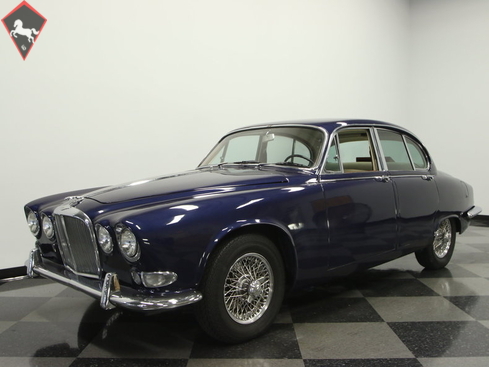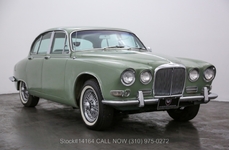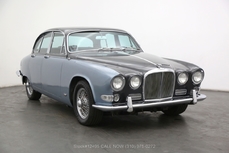Jaguar 420 Salon 4.3L Vortec V6 1967
General description :
4.3 VORTEC V6, 700R4 4 SPEED AUTO, COLD A/C, BEST OF BOTH WORLDS, RELIABLE JAG
Beautiful inside and out, this 1967 Jaguar 420 has a hidden secret. The motor is exceptionally simple to maintain thanks to an upgrade to 4.3 liters of Chevy power. So you can look great while having the confidence to go the distance in this A/C classic sedan.
The look is unmistakable Jaguar, but this car is quite unique. Only in production for three years, the Jaguar 420 sedan (ok, saloon for the purists) is a great midpoint design between the Mark series and the revolutionary XJ. It is presented exceptionally well today on this fully sorted example. Wraparound chrome bumpers, complete trim, and all four doors shut with confidence – it's a cut-above restoration, but there's much more going on here. You could never get this kind of blue on a car in the 1960s, even on a premium marque. Instead, this metallic shade is the product of an investment in a modern clearcoat with a very professional hand. But not everything needs modernization. After all, no one can improve on Jaguar wire wheels with knock-off spinners.
Inside is true British luxury. That means plenty of real wood on the dash and plush tan leather seating. The comfort continues with a long list of desirable features such as individual armrests up front, power steering, and an upgraded AM/FM/CD stereo. The air conditioning even blows nice and cold like a luxury car should. But Jaguars also have a sporting heritage, which you can see in the full set of Smiths gauges.
Lift the hood for an interesting surprise. This Jaguar has been given a transplant of 4.3-liters of fuel-injected Chevy power. The wide availability of components Vortec motor means more reliability and better component availability. The 700R4 four-speed automatic transmission w/overdrive was also donated from GM. But what makes this a great car is the Jaguar drivetrain is still intact. That means a European-tuned fully-independent suspension and four-wheel disc brakes. So this car is the perfect blend of a reliable heart and precision legs.
This car is rare and very unique...and when it's this affordable, you know you have to act quickly to snatch it up. Call today!!!
Features : AM/FM Radio, CD Player, Air Conditioning, Heat, Leather Seats, Four Wheel Disc Brakes, Fuel Injection, Power Brakes, Power Steering, Seatbelts-Front
http://www.streetsideclassics.com/vehicles/0466-tpa/1967-jaguar-420
1967 Jaguar 420 Salon 4.3L Vortec V6 is listed sold on ClassicDigest in Lutz by Streetside Classics for $12995.
Car Facts
Car type : Car Make : Jaguar Model : 420 Model Version : Salon 4.3L Vortec V6 Engine size : 0.0 Model Year : 1967 Sub type : Coupé Location : Tampa
Sold
Seller Information
Sold
People who viewed this Jaguar 420 also viewed similar Jaguar listed at ClassicDigest
About Jaguar
Ah, the story of Jaguar, from its early days as the SS Cars Ltd. to its pinnacle with the D-type, and the street-going evolution in the form of the iconic E-type. There's something quintessentially British about this tale, and I'll narrate it as a British journalist might.In the Beginnings:
Our journey into the world of Jaguar begins in the 1930s, when a company known as SS Cars Ltd. emerged. Despite the unfortunate coincidence of their initials with the rising political tensions in Europe, they started producing stylish and performance-oriented cars. The SS 100, introduced in 1936, was a symbol of elegance and speed, setting the stage for what would become Jaguar.
The Birth of Jaguar:
As the shadows of World War II loomed, SS Cars Ltd. wisely decided to disassociate themselves from the SS initials. Thus, in 1945, they officially became Jaguar Cars Ltd., a name that would soon be synonymous with British luxury and performance.
The XK Series:
Jaguar's post-war era brought us the XK 120, a true sensation in 1948. With its sleek design and a powerful 3.4-liter inline-six engine, it became the world's fastest production car. The XK 120 was the blueprint for what lay ahead – Jaguars that blended style with speed in a uniquely British fashion.
The D-type Dominance:
Then came the D-type, a true racing legend. Introduced in 1954, it won Le Mans three times in the 1950s, showcasing Jaguar's engineering prowess. With its innovative monocoque construction and the iconic fin at the back, the D-type was the apex of Jaguar's motorsport success.
The E-type Emergence:
But the true turning point arrived in 1961 with the introduction of the E-type, often described by Enzo Ferrari as "the most beautiful car ever made." Its long bonnet, curvaceous body, and a 3.8-liter engine delivering exhilarating performance made it an instant classic. The E-type was not just a car; it was a work of art on wheels, and it could hit 150 mph on the road.
Street and Racing Success:
The E-type's beauty was matched by its capability on the track. The lightweight E-types were particularly successful in various racing events, cementing Jaguar's reputation as a force to be reckoned with in motorsport.
The Age of Refinement:
As we delve deeper into the Jaguar story, we find that the 1950s and 1960s were an age of refinement and expansion. Alongside the magnificent D-type and the E-type's iconic emergence, Jaguar introduced models that further solidified its reputation for luxury and performance.
The MK2:
In the late 1950s, Jaguar unveiled the MK2, a sports sedan that combined elegance with power. This sleek four-door saloon was a favorite of bank robbers and law enforcement alike, thanks to its exceptional speed and handling. The MK2 was a symbol of Jaguar's ability to blend sophistication with performance and had a successful racing career as well.
The XJ6:
Fast forward to 1968, and Jaguar launched a car that would define luxury saloons for decades to come – the XJ6. It was a masterpiece of engineering and design, featuring a smooth inline-six engine, independent rear suspension, and a spacious, beautifully appointed interior. The XJ6 was a symbol of British elegance and provided a ride so smooth that it seemed to glide over the road. It became the flagship model for Jaguar and set the standard for luxury saloons, showcasing a level of refinement that left competitors in awe.
The Blend of Classic and Modern:
While the MK2 and XJ6 represented the evolution of Jaguar's saloon cars, they maintained the brand's commitment to performance and luxury. These cars didn't just belong on the racetrack; they were equally at home cruising down the grand boulevards or gliding through the English countryside.
The Challenges of Change:
However, as the 1970s arrived, Jaguar, like many British automakers, faced financial challenges and changes in ownership. The British Leyland era brought both opportunities and struggles, as the brand navigated through various mergers and transitions.
Nevertheless, the legacy of the MK2 and XJ6, along with the D-type and E-type, continues to define Jaguar as a manufacturer that combines timeless elegance with a spirit of performance. These classic models, whether driven on winding roads or parked as collectors' treasures, serve as a testament to Jaguar's enduring presence in the world of automotive excellence.
The Jaguar story, from its early days as SS Cars Ltd. to the creation of automotive icons like the E-type, MK2, and XJ6, is a journey that reflects the very essence of British motoring – a blend of luxury, power, and style that continues to captivate enthusiasts and connoisseurs alike.





